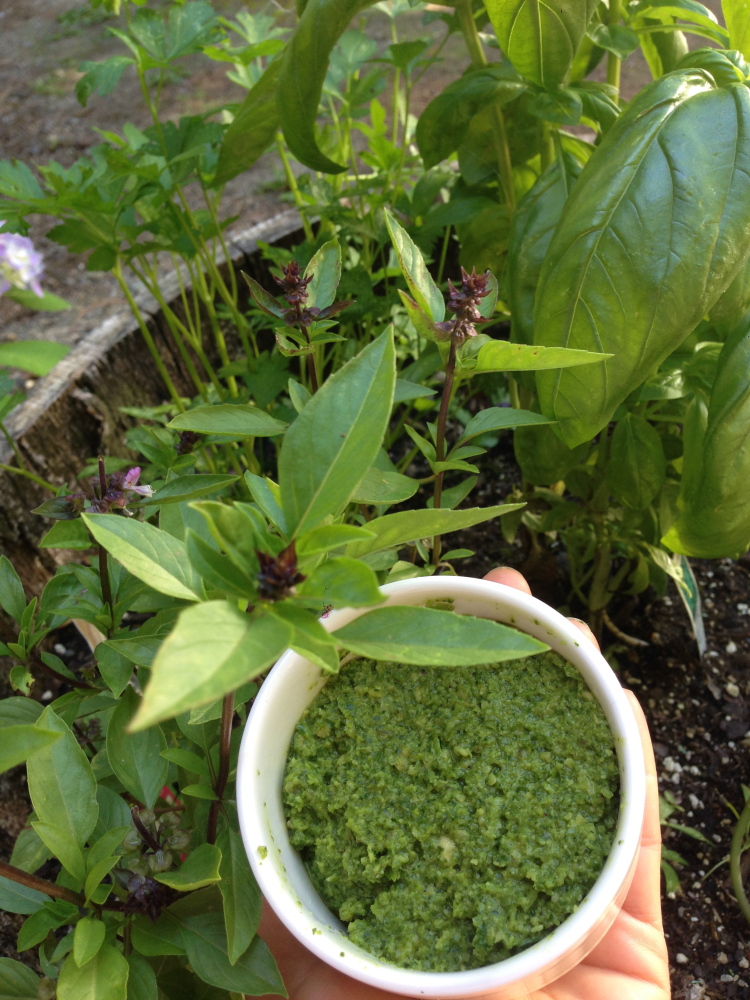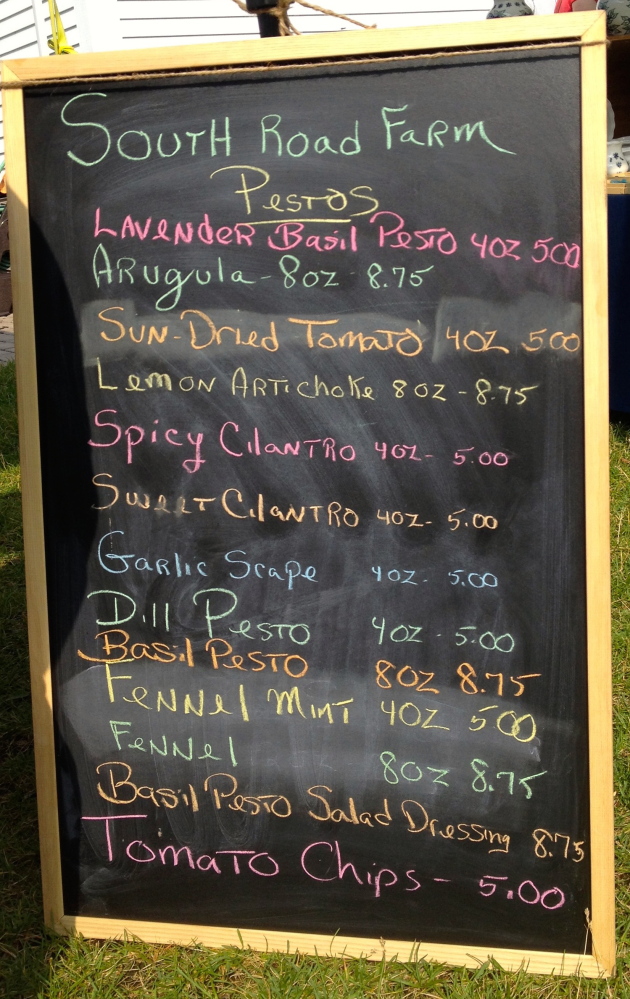We’re staying put for Maine’s fleeting summer, and grateful so many family members and friends come to us instead. But sometimes, amid the hubbub, it’s hard to find time to puree pesto, even though the basil has come on thick, to go berry picking and make jam or even shell a bag of English peas, much less tend the garden or cook.
In fact, these can be the perfect communal kitchen activities for bonding with your guests (and your children) – a delicious reminder of your Maine time together. And making garden-fresh pesto is a good place to start.
We’re always tempted to put off pesto until peak tomato season cues mozzarella-basil caprese salads, sandwiches, pizzas and pastas. But we could miss the opportunity if we wait.
Who knew our family’s favorite summer herb faces a new, widespread disease known as basil downy mildew that causes many East Coast basil plants to mysteriously perish midseason? Eric Sideman, crop specialist for the Maine Organic Farmers and Gardeners Association (MOFGA), saw the pathogen on most Maine farms he visited last summer. Worse, it has no real remedy and seems here to stay.
So that’s why my community-garden basil looked so heat-stressed and burned yellow last summer, with fuzzy patches on the undersides of sick leaves. Downy mildew prematurely killed their crop by late July last summer, said Laura and Ben Whatley, the mother-son duo behind Whatley Farm in Topsham. You’d never know from the bountiful bouquets of many varieties – including purple, Napoletano and lime basils – they’re selling now at Brunswick markets.
Fortunately, the lemon, Thai and spice basil varieties the Whatleys grow are less susceptible to downy mildew than ubiquitous sweet (Genovese) basil with those fat, cupped leaves. They’re also giving new disease-resistant Genovese types a try.
Moreover, basil mildly afflicted with downy mildew can still mash up into fine pesto. MOFGA’s Sideman writes that harvesting any susceptible basil varieties early is the best defense. So don’t put off pesto.
Farmers can plant succession crops, too, so we should have later summer basil that matured under drier conditions, which minimizes the spread of spores.
Even so, there’s still the challenge of getting kids to eat pesto. My 3-year-old son Theo seems more interested in sniffing basil out in the garden, where he helps me pick it to top the blank canvas of Flipside Pizza we order with just cheese and tomato sauce. Theo also prefers his pasta plain, with just olive oil or butter, or if he’s in the mood, with a little tomato sauce. He’s suspicious of pesto unless it’s disguised in red.
But the boys at Camp Chewonki in Wiscasset aren’t. They chowed down on pesto pasta when Laura Whatley recently lunched there with her 11-year-old nephew, a camper up from New Jersey. And not just any pesto, but an unusual, healthful one made with holy basil (tulsi), grown at Chewonki’s own farm, pureed with pepitas (hulled, green pumpkin seeds).
Nor should we limit ourselves to basil. Portlander Dyanna Lincoln spends summers gardening at her aunt’s South Road Farm in Fayette, churning out inventive pestos that she sells at my parents’ lakefront Sunday farmers market in Belgrade. My mom loved the surprising lavender flower-basil pesto; other blends include arugula, lemon-artichoke, spicy cilantro, fennel-mint and dill.
South Road Farm, which processes out of the Farmington Grange’s commercial kitchen, distributes through the Crown O’ Maine Organic Cooperative, and will be sold at the new Portland Food Co-op this fall.
PESTO DETOURS EAST
The purple-stemmed Thai (or Siam or Saigon) basil is a favorite in my family, since our palates lean toward Asian flavors. We love Thai basil garnishing Vietnamese pho noodle soups, in Vietnamese rice-paper salad rolls (sweet basil works just as well), stewed into Thai green curries, and minced with cilantro and parsley atop Brazilian lobster-and-redfish moqueca (another coconut milk stew).
Still, I’d never thought to make Thai basil pesto until my chef friend from Oregon, Intaba Liff-Anderson, suggested a brilliant concoction on a recent visit here. At her Fireworks restaurant in Corvallis, Intaba combined basil with peanuts, or cashews, and coconut oil. In her former vegan, macrobiotic years, Intaba, who trained at The Natural Gourmet Institute in New York, made pesto with white soy or chickpea miso as a salty, umami-rich substitute for Parmesan cheese (tangy nutritional yeast works, too).
Intaba and I bought Whatley Farm basils at the Tuesday market on the Brunswick green, but we ran out of time to make pesto, after foraging for chanterelles on a trail run and canning local honey-sweetened strawberry-rhubarb jam. So I brought the still vibrant but days-old basil, covered in a plastic bag with stems hydrating in a Mason jar filled with water, to my parents’ camp. I made pesto in my mom’s cracked Cuisinart, which is almost as old as I am (35), while my sister Carolyn kept Theo from jumping off my parents’ dock.
Cooking with my parents, and with chef friends like Intaba, reminded me to view pesto recipes as templates for whatever herbs, nuts, oils, cheeses and alliums you have on hand.
A handful of kale or spinach can keep pesto green, since minced basil is quick to oxidize. Parsley, cilantro, mint, oregano and arugula can stand in its stead. When you run out of storage garlic, use garlic scapes, shallots or scallions to tide you over. Thankfully, fresh, uncured green garlic has finally resurfaced at local markets.
KEEPING IT GREEN
Traditionally in northern Italy’s Liguria region, pesto is pounded by mortar and pestle. It’s worth the elbow grease to try some this way, releasing the basil’s heady aroma. But I prefer an appliance with horsepower when making a big batch. I’ve used my Vitamix blender lately but still prefer the less emulsified consistency of pesto mixed by food processor.
The pulverizing Vitamix also made me lazy about removing basil leaves from stems. I’ll be more careful to do so now, given culinary chemist Harold McGee’s finding that stems and stalks turn brown faster than chlorophyll-filled leaves.
In “The Curious Cook,” McGee details his experiments to limit basil oxidation. He found blanching basil leaves for just 5 seconds kills browning enzymes (and sadly, the fresh basil flavor). Cooking the pasta in water acidulated with lemon juice or cream of tartar helps. Pine nuts, rather than walnuts or sunflower seeds, also make for a greener pesto.
Pine nuts, which my mother often burned roasting in the toaster, never seemed worth the expense to me. Problems with cheap ones imported from China further turned me off. In Oregon, everyone made pesto with native hazelnuts instead. Here, I use walnuts, pecans or almonds, and I recently tried those pepitas.
To store in the fridge for a couple weeks, cover pesto with a thin layer of olive oil. My friend Intaba says thoroughly drying the basil leaves after a rinsing in water helps the oil blend in, making a longer-lasting pesto.
But freezing is the way to put up a batch. For individual portions, use a plastic wrap-lined ice cube tray (you can also freeze plain basil in olive oil this way) or freeze it flat in airtight sealable bags, breaking off a piece “whenever you need a little pesto fix,” Oregon food writer Ivy Manning advises in “The Farm to Table Cookbook.”
When I grate Parmesan on my family’s defrosted pesto this winter, the scent will bring me straight back to summer – my mother’s cranky Cuisinart, Intaba’s ever-amazing imagination in the kitchen, time with Theo in the garden, Whatley Farm’s aromatic herb bouquets and, deep in the reaches of memory, a family trip to Europe, including Genoa, Italy, the pesto homeland that awoke the palate of a 12-year-old American girl (me).
We should teach our children pesto is much more than the sum of its parts. Even if they shun green things, pesto’s flavor comes from familiar things they love: nuts, cheese, oil, salt, if not garlic. Smash in some basil, not to mention a splash of truffle oil or ume plum vinegar, and you elevate these everyday ingredients to a more transcendent realm. Maybe if I called it “green juice,” smoothie-loving Theo would embrace my family’s favorite condiment, made with the somewhat imperiled staple herb the world so reveres.
THAI BASIL PESTO
I substituted cilantro and mint for some of the basil. Add coriander and cumin seeds, and ginger and lemongrass (and ideally, kaffir lime leaves), and this pesto approaches Thai green curry paste. Avocado could replace the coconut oil. This refreshing pesto was delicious with leftover shredded pork carnitas meat – it would also complement chicken or fish. Toss it with Asian rice noodles or tuck in Vietnamese salad rolls and stir it into soups. Pesto recipes are meant to be riffed on – experiment away!
Makes about 8 ounces
2-plus cups Thai (or sweet) basil, loosely packed
½ cup kale or spinach
4 to 5 garlic scapes, flower end removed
1 small shallot
½ cup salted roasted peanuts (or cashews or pepitas)
Zest and juice of 1 lime
Fish sauce, several dashes (to taste)
Sriracha or green bird chile (to taste)
¼ cup unrefined coconut oil
Combine all ingredients except the coconut oil in the bowl of a food processor or blender (or mortar and pestle, if you’re a purist) and pulse until combined. Add the oil and blend again. Taste and add more fish sauce or Sriracha if the flavor needs enhancing.
Send questions/comments to the editors.




Success. Please wait for the page to reload. If the page does not reload within 5 seconds, please refresh the page.
Enter your email and password to access comments.
Hi, to comment on stories you must . This profile is in addition to your subscription and website login.
Already have a commenting profile? .
Invalid username/password.
Please check your email to confirm and complete your registration.
Only subscribers are eligible to post comments. Please subscribe or login first for digital access. Here’s why.
Use the form below to reset your password. When you've submitted your account email, we will send an email with a reset code.